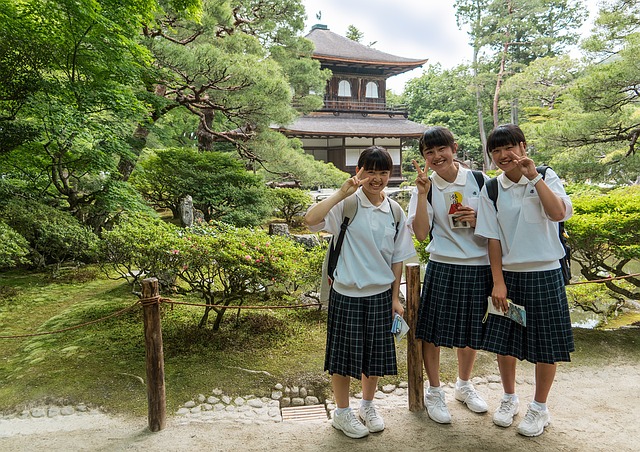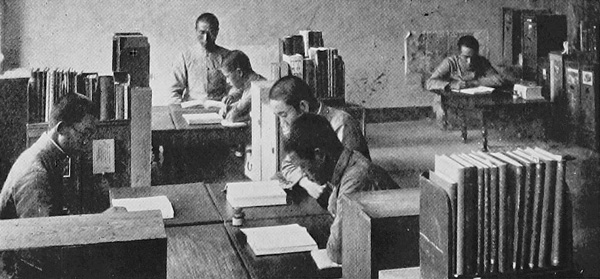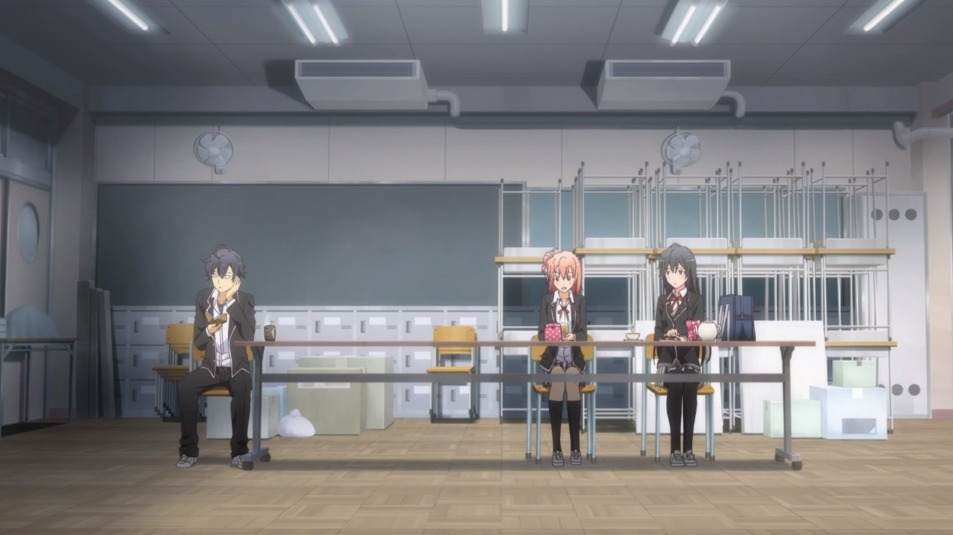I will mix things up a bit for our ninth Sunday content recommendations from around the web. In this post, I will cover a series of articles on black hair color being part of the dress code at many Japanese schools. While the purpose of the rule at these schools is ostensibly to prohibit hair-dying, an obvious problem arises if a Japanese student at the school has hair that is naturally non-black. This problem resulted in conflicts and led public schools in Tokyo to clarify their policies.
After I examine the hair color stories from Japanese schools and offer my own thoughts, I have two additional articles about hair length issues in Japanese schools. The hair-length articles segue into a story from my own time in high school, which I will share. Finally, I will recommend a very-tangentially related post from our own archive here at The New Leaf Journal, which itself previews a follow-up hair article.
March 13, 2022 Update: I published a follow-up article about the Tokyo School Board changing its policies regarding students with naturally non-black hair.
Featured Content Recommendation: Forcing Students in Japan to Dye their Hair to Conform With No Hair-Dying Policy
SoraNews24: “Tokyo public schools will stop forcing students with non-black hair to dye it, official promises”
By Casey Baseel. August 3, 2019.
The Rationale of Making Hair Color a Part of the Dress Code at Japanese Schools
Many Japanese middle and high schools value conformity. For that reason, they go a step beyond dress codes, requiring students to wear uniforms. Contrary to the impression one might get from watching anime and consuming other forms of Japanese media, the overwhelming majority of Japanese people have naturally black hair. Putting all of this together, a not-insignificant number of Japanese middle and high schools made black hair part of the dress code, as if hair color were the same as a uniform blazer or collared shirt adorned with the school’s crest.

For schools that made black hair part of the uniform, the reasoning was simple enough. As Mr. Casey Baseel put it in his article: “The ostensible reason for the rule is that almost all Japanese people have naturally black hair, and so they’ll only have non-black hair if they’ve chosen to dye it a different color.”
In theory, making black hair part of the dress code or uniform requirements was intended to be a prohibition against students dying their hair. Mr. Baseel previewed the problem with this blanket rule when he described its rationale. While it is true “that almost all Japanese people have naturally black hair,” almost necessarily means that some do not. What happens to the rare Japanese student who does not have naturally black hair and is prohibited from dying his or her hair? Something has to give, it would seem.
A Hairy Situation at an Osaka Middle School
Mr. Baseel discussed an unfortunate 2017 case in an Osaka school. There was a junior high school student who had naturally brown hair. Notwithstanding her school’s otherwise normally applicable prohibition against dying hair, the school district decided in its infinite wisdom to force her to repeatedly dye her hair black in order to cover up her natural hair color.
A writer-translator duo at SoraNews24 that goes by “Master Blaster” reported on the story on October 28, 2017, in an article titled “Naturally brown-haired Osaka student sues government for forcing her to dye her hair black.” Master Blaster explained that some schools with hair color requirements in their dress codes maintain a “Natural Hair Color Registry.” This allows students who have naturally non-black hair to have that fact noted by the school in order to ensure that the school recognizes that they are not dying their hair. The mother of the student in question in the instant matter asked the school if it had a Natural Hair Color Registry when her daughter enrolled. The school informed her that it did not, but the mother left the meeting with the impression that the school understood the situation.
However, the mother’s optimism turned out to be misplaced. Within two weeks of classes starting, her daughter was being pressured by teachers and administrator’s to dye her hair. The student in question filed suit against the district when she turned 18. The district defended itself by arguing that foreign students with non-black hair were also required to dye their hair. I find nothing disagreeable with Master Blaster’s take on that argument: “It bears repeating; the absurdity that they are required to dye their hair by a rule intended to prohibit dying of hair.”
The Real-World Effects of Forced Hair-Dying
While it is easy to mock the junior high school’s logic in the Osaka case, the details of the suit itself reveal that its absurd policy had the very real effect of tormenting a young girl and ruining several years of her life.
The girl attempted to comply with the school’s demands, but by her second year at the school officials began demanding that she die her hair about once every four days, according to the suit. This became increasingly difficult for her due to the effect that the constant bleaching and dying had on her hair and her scalp. In periods when she did not dye her hair to the satisfaction of school officials, she was prohibited from taking part in school events such as festivals and field trips. On one occasion, according to the suit, a teacher asked her whether the fact that she had a single mother was what was making her defy the school. The school eventually expelled her, effectively halting her education.
According to Mr. Baseel’s article to which we will now return, the lawsuit was still ongoing as of August 2019.
A Welcome Policy Clarification on Hair and Dress Codes in Tokyo
While the Osaka school fought on, Mr. Baseel reported on some good news from the Tokyo Metropolitan Board of Education.
On July 30, 2019, a gentleman by the name of Mr. Hiroki Komazaki presented a petition to the Tokyo Metropolitan Board of Education asking for the Board to prohibit all schools under its jurisdiction from ordering students who have naturally non-black hair to dye their hair. He had managed to gather 19,065 signatures on his petition since that May.
The Tokyo Metropolitan Board of Education responded favorably-in-part to the petition. Mr. Seiichi Sato stated unequivocally in response to the petition that “[w]e will not direct students with natural non-black hair to dye their hair black.” He declined, however, to direct all public schools within the jurisdiction of the Tokyo Metropolitan Board of Education to post this policy on their official websites – stating that the purpose of the websites was to communicate what makes each school unique, not to articulate official policies.
Mr. Sato was satisfied with the mostly-favorable response to his petition. For his part, he stated that he did not exclusively blame schools and teachers for absurd cases like the one we examined from Osaka. Mr. Sato opined that some teachers may recommend that students dye their hair black with an eye toward fostering their fitting into Japanese society and having good employment prospects. The latter point, Mr. Sato suggested, was not incorrect . For that reason, Mr. Sato suggested that it was not enough for only schools to reverse their policies, he stated that “[c]ompanies and society must also change their way of thinking.”
Mr. Baseel qualified the good news by noting that the Tokyo policy only applies to public schools, so private schools in Tokyo may still retain forced-hair-dying policies if they are so inclined.
Some Thoughts on Forced Hair-Dying and Japanese School Dress Codes
To start, I have no issue with schools prohibiting hair dying, or at a minimum restricting the colors with which students can dye their hair. For example, if a school has a dress code, it would be a bit odd to allow students to show up with blue hair. Like any dress code rule, hair color rules must be communicated to students and parents clearly from the outset, and they must not only be reasonably enforced but also in an equal and impartial manner.
Forcing students to dye their hair because the school disapproves of the student’s natural hair color is categorically unreasonable. The practice should be abolished, and it is good to see that Tokyo public schools appear to have taken concrete steps to prohibit it.
Regarding Mr. Sato’s thoughts, I do think it is appropriate in the context of career guidance in high school to make students aware of problems they may have when looking for jobs, especially for students who are foregoing college. There is a category difference, however, between having an honest discussion with a brown-haired student about the fact that some employers may have a bias against hiring people with brown hair and forcing the student to bleach his or her hair and dye it black. The former course of action prepares students for difficulties they may face in the real world, including unfair ones. The latter unfairly targets students for having the “wrong” hair color and, as we saw in the Osaka case, can ruin not only hair and scalps but also lives when taken to an extreme.
Additional Article Recommendations: Forced Hair Cuts in Japanese Schools
While I was previously aware of the forced-hair dying debate in Japanese schools, I had not seen the news from a couple of years ago about Tokyo’s policy clarification. I did not find that article straight-away, however, but instead because it was linked to another article about hair in Japanese schools. Below, I will present two additional article recommendations, also from SoraNews24, wherein educators decided to take enforcing hair-related dress code requirements into their own hands.
SoraNews24: “Japanese high school teachers forcibly cut off hair that was ‘too long’ from 44 students”
By Scott Wilson. February 10, 2018.
Forcing students with naturally non-black hair to dye their hair is absurd. Conversely, having limits on how long a student’s hair can be is not presumptively unreasonable, in my view. I chose the words “not presumptively unreasonable” for a reason. Long hair that is clean and appropriately groomed does not affect the ability of a student to participate in school and does not interfere with the ability of other students to do likewise. That is, hair rules may be reasonable so long as the limits make sense and they are clearly communicated to students and parents from the beginning.
Furthermore, the remedies for violations must be appropriate. For example, I would suggest that a student whose hair runs afoul of the school dress code may be given a warning and told to rectify the situation, with a warning to parents if the student does not comply. That is, the violation could be treated like any other dress code or uniform violation.
Mizuhashi High School in Toyama Prefecture took a different approach. Teachers performed monthly uniform checks, and if the teachers determined that any students had hair that was too long, the teachers proceeded to cut it themselves. Over the course of a year, the teachers reportedly performed 44 haircuts, assuring us that all the affected students “consented.”
When reached for comment, the headmaster of the school, Mr. Yasuhiro Nakada, stated that the teachers were wrong and it should not have happened. Mr. Wilson had some difficultly believing the headmaster’s suggestion that he had not known what was happening in his school for a year. I share his doubts.
SoraNews24: “Japanese high school teacher in hot water after forcibly giving male student a buzz cut”
By Koh Ruide. April 3, 2019.
Mr Ruide wrote: “In late autumn last year, a male teacher in his forties allegedly grabbed an electric hair clipper and gave one of his first-year male students a buzz cut, causing the boy take a leave of absence from school shortly after.”

Well, that’s definitely not insane. You will be very surprised to learn when you read the first article that Mr. Buzz Cut appears to have had some anger management issues that went beyond his unauthorized use of hair clippers.
A Ridiculous Hair-Length Story From My High School Days
Bizarre hair dress code stories are not an exclusively Japanese phenomenon. What is my proof? Below, I present to you a story from my own high school many years ago.
The Unreasonable Demand
My high school had a dress code on paper for boys and girls. However, in reality there was a dress code for boys and no dress code for girls. A boy who wore jeans to school might be removed from class. A girl who wore juicy couture to school would be fawned over by three-quarters of her teachers. As one of the many inspirations for my “Justin” character once opined in a paper about the the situation in our history class, “the girls could come to school in yellow jumpsuits with flower pots on their heads.”
The absurdity reached a crescendo one day during my third year in high school. There, one of my former teachers demanded that my friend – and friend of The New Leaf Journal – cut his hair in order to be allowed to give a required class presentation. For one, his hair did not violate the dress code. For two, a dress code that only applies to boys is no dress code at all. My friend, who had both sense and pride, correctly refused to back down. I opined to the teacher that one of his female students who he had been talking to about 15 minutes before was wearing a pink sweatsuit that was too small for her. Rest assured that neither pink sweatsuits nor clothes that were too small were in the dress code. He demanded that I stay out of it. I declined.
Victor V. Gurbo Makes His Decision, Petition
The student who was targeted decided to start a petition to overturn the decision. My New Leaf Journal colleague and former classmate, Victor V. Gurbo, helped circulate the petition which I readily signed. Many others signed too even though it was after school and most people had gone home. The petition turned out successful. Apparently, the teacher-in-question’s demands were too absurd even for the people who oversaw our fake dress code, and the discriminatory demand was rescinded before we all left for the day.
Let this story serve as an additional reason I suggested, that while hair length restrictions are not presumptively unreasonable, they are also not presumptively reasonable.
The Old Leaf Journal 〜 Recommendation From Our Archive
The New Leaf Journal: “That Longest Year of School Finally Ends”
By Nicholas A. Ferrell. September 26, 2020.
I wrote this article in September about the end of one of my favorite anime series, My Teen Romantic Comedy SNAFU!, based on the lite novel series, My Youth Romantic Comedy Was as Wrong as I Expected. The series later featured in my post on anime recommendations for a wide audience that aired from 2011-2020.

The post on this series has nothing to do with hair, but it is instead about finding closure on a period of one’s life. I wrote it so that anyone who is not familiar with the series can follow it, but also in a way that does not spoil the series for those who may be interested.
August 22, 2021 Update: I referenced My Teen Romantic Comedy SNAFU because I published a follow-up article about hair color in that anime series that references the instant article. That article covers the case of Iroha Isshiki, a fictional novel and anime character who we are told has naturally brown hair, despite being fully Japanese. Sadly, I forgot to update this article for several months. You can read the article about Iroha here.